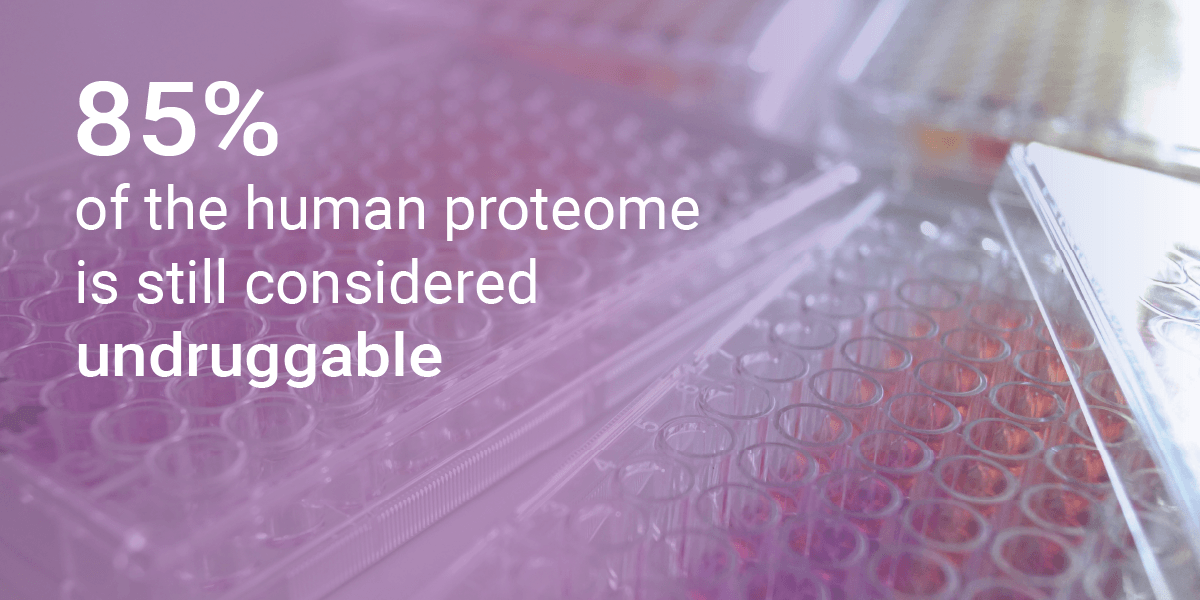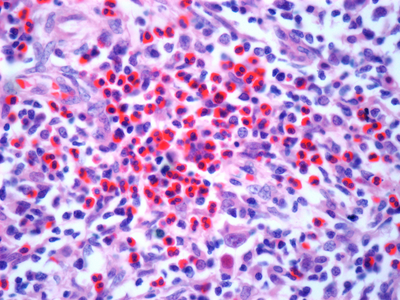Introduction
Most cancers contain mutations or amplifications of genes. This leads to the production of abnormal proteins, which are responsible for uncontrolled cell growth and the survival of tumour cells. Some of these cancer-driving proteins have been difficult to target pharmacologically and are therefore often referred to as “undruggable” targets. At CancerTools.org, we support basic research in these “undruggable” targets, by making tools developed in these research labs easily available through a single centralised online location.
Read more about difficult-to-drug targets in cancer and explore our selection of relevant reagents developed by key contributors in the field.

What are undruggable targets and why are they relevant to cancer?
Despite numerous tumourigenesis drivers, especially kinases, being successfully used for drug intervention, estimates suggest that 85% of the human proteome is currently undruggable (1). In addition, out of the 5,000 proteins with bindable pockets in the ChEMBL database, only approximately 700 proteins are therapeutic targets for FDA approved drugs (2).
Nevertheless, the notion of undruggable targets has considerably changed over the last few decades and the term is becoming increasingly inaccurate. A few so-called undruggable targets, such as Bcl-2 and RAS, have been successfully targeted with clinically approved inhibitors. Therefore, “difficult to drug” or “yet to be drugged” are more appropriate terms to describe such targets (3).
Intractable targets continue being a key challenge in targeted therapeutics for cancers, together with understanding tumour heterogeneity and resistance mechanisms. Key proteins belonging to difficult-to-drug targets in cancer are often known oncogenes or tumour suppressors. These include transcription factors such as MYC, MYB, p53, STAT3, nuclear factor-κB (NF-κB), and fusion transcription factors frequently associated with paediatric cancers. The RAS family also belong to these proteins, with RAS being mutated in up to 30% of human cancers (4).
Challenges of developing drugs against intractable targets
So far, therapeutic approaches have mostly focused on small molecules and biologics, which target proteins with hydrophobic pockets, those located on the cell surface and those that have been secreted. Due to this approach most potential protein targets, such as transcription factors have been left poorly explored (3,5).
One major challenge with difficult-to-drug proteins arises from the fact that many of them function through protein-protein interactions (PPI). They are often intrinsically disordered proteins, thus relying on their interaction with functional partners and lack a sufficient interaction surface for effective and specific drug binding. In addition to their intracellular localization, these targets frequently lack suitable binding sites that allow inhibition of their functions and play crucial roles in cellular processes such as proliferation and development (3,6,7).
These features have made the drug development for these targets difficult to attain, especially when using conventional therapeutic approaches. However, these challenges have also pushed research boundaries, and the “undruggable” targets of yesterday now represent a promising new area of research.
How researchers are tackling these challenges
Several factors underpin the erosion of the “undruggability” concept, including the development of therapeutics with novel mechanisms of action. These not only include PPI modulators, but also cell therapies, T-cell receptor mimetics and multifunctional small molecules (e.g. proteolysis-targeting chimeras [PROTACs], peptides/peptidomimetics, nucleic acid–based therapeutics)(7,8,9)*.
A few decades ago, PPIs were commonly regarded as “undruggable”. However, the number of inhibitors approved or under clinical investigation has significantly grown over the years, as the basic knowledge of PPI structure and energetics has expanded. The approval of the Bcl-2 inhibitor, Venclexta, in 2016 for the treatment of chronic lymphocytic leukaemia represented a milestone in this space (10).
The accelerated approval granted by the FDA in 2021, to the first KRAS inhibitor, Sotorasib, (for non-small cell lung cancer with G12C mutation of KRAS) represented a breakthrough in the field, given the previous absence of treatments counteracting the cancer-promoting actions of mutated KRAS proteins (11).
Difficult-to-drug targets, such as MYC, NF-κB and RAS, are essential nodes for cancer maintenance and progression. Pathways regulated by these proteins are often activated in resistant tumours to circumvent the action of targeted therapies, such as kinase inhibitor, and can cause such resistance. Therefore, developing inhibitors that target such proteins is essential to achieve successful inhibition of tumour growth, especially in cancers where an effective targeted therapy is not yet available. Since these nodes serve as a conduit for multiple oncogenic signals, their targeting could also be efficacious in multiple types of cancer, thus reducing the number of agents required (3).
Importantly, the transition from “undruggable” to “druggable” targets is driven by the availability of structural insights and improved understanding of the biochemical and biological properties of these drug targets. Therefore, continuing basic research in difficult-to-drug targets remains crucial to generate insights and greater understanding into the biological mechanisms of difficult-to-drug targets that can be used in the development of new therapeutic options for cancer patients.
How CancerTools.org is supporting research in difficult-to-drug targets
CancerTools.org supports basic research in difficult-to-drug targets by offerings a selection of relevant tools through a single centralised online location. These include established and novel research tools to investigate MYC, p53, RAS, and Bcl-2. The collection features p53 antibodies created in the laboratory of Prof. Sir David Lane, who discovered this crucial tumour suppressor gene, as well as anti-Omomyc, an antibody developed by Laura Soucek. While the dominant negative Omomyc was first designed as a laboratory tool to study Myc perturbation, it was successively characterised as Myc inhibitor and is currently undergoing clinical development.
Conclusion
Having the right tools to investigate difficult-to-drug targets is crucial to drive technological advancement within the space and has the potential to support a new class of highly targeted cancer treatments, alongside as well as reducing the list of undruggable proteins.




